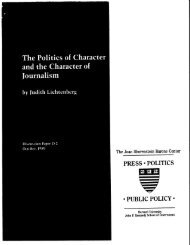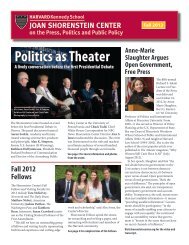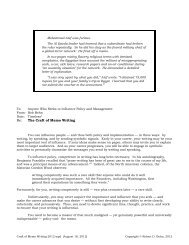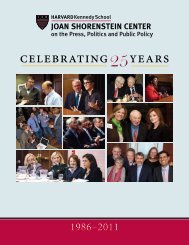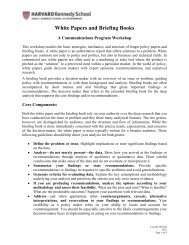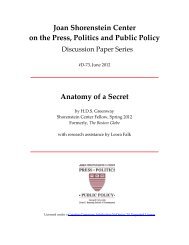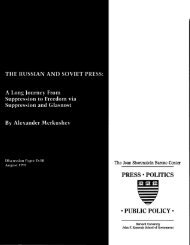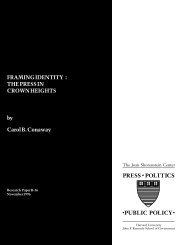Why Paper Is Eternal - Joan Shorenstein Center on the Press ...
Why Paper Is Eternal - Joan Shorenstein Center on the Press ...
Why Paper Is Eternal - Joan Shorenstein Center on the Press ...
Create successful ePaper yourself
Turn your PDF publications into a flip-book with our unique Google optimized e-Paper software.
to deliver informati<strong>on</strong>, as l<strong>on</strong>g as <strong>the</strong> informati<strong>on</strong> reaches its intended recipient.<br />
Of course, <strong>the</strong> main purpose of a c<strong>on</strong>tainer is storage. A Tupperware c<strong>on</strong>tainer<br />
stores last night’s leftovers, and a newspaper stores news for <strong>the</strong> journey it<br />
must make between <strong>the</strong> printing plant and <strong>the</strong> reader’s doorstep. But <strong>the</strong><br />
argument that hard-copy newspapers are just c<strong>on</strong>tainers implies that of <strong>the</strong> two<br />
roles paper performs, <strong>on</strong>ly <strong>on</strong>e has value: <strong>the</strong> storage role. Since that happens<br />
to be <strong>the</strong> role paper is losing over time, it’s no w<strong>on</strong>der that, by <strong>the</strong> lights of <strong>the</strong><br />
c<strong>on</strong>tainer school, paper appears doomed.<br />
Though paper’s work has been shifting away from storage and toward<br />
communicati<strong>on</strong>, for some reas<strong>on</strong> we seldom think or talk about what exactly<br />
happens when paper communicates. This is because media communicati<strong>on</strong><br />
appears to be a form of transportati<strong>on</strong>: Like UPS trucks, informati<strong>on</strong><br />
technologies simply move product from <strong>on</strong>e place to ano<strong>the</strong>r. However, <strong>the</strong>re<br />
is <strong>on</strong>e important way in which <strong>the</strong>y are not like trucks at all. After informati<strong>on</strong><br />
arrives at its destinati<strong>on</strong>, something else has to happen for <strong>the</strong> communicati<strong>on</strong><br />
to be complete: The individual must interact with <strong>the</strong> medium, using his or her<br />
senses and cognitive abilities to understand <strong>the</strong> c<strong>on</strong>tent. In <strong>the</strong> case of paper,<br />
this is <strong>the</strong> moment when we pick up a sheet, or dozens of sheets joined<br />
toge<strong>the</strong>r to form a newspaper, magazine or book, and begin reading. If we<br />
could get to <strong>the</strong> bottom of that moment – which we take for granted, though<br />
it’s a profound, almost magical event – we might be able to say why paper has<br />
endured this far into <strong>the</strong> age of electr<strong>on</strong>ic media, and whe<strong>the</strong>r it will c<strong>on</strong>tinue<br />
to figure in our lives.<br />
Which points to <strong>the</strong> o<strong>the</strong>r reas<strong>on</strong> why, in trying to make sense of our<br />
own media landscape, it’s helpful to keep Hamlet and his erasable tables in<br />
29



